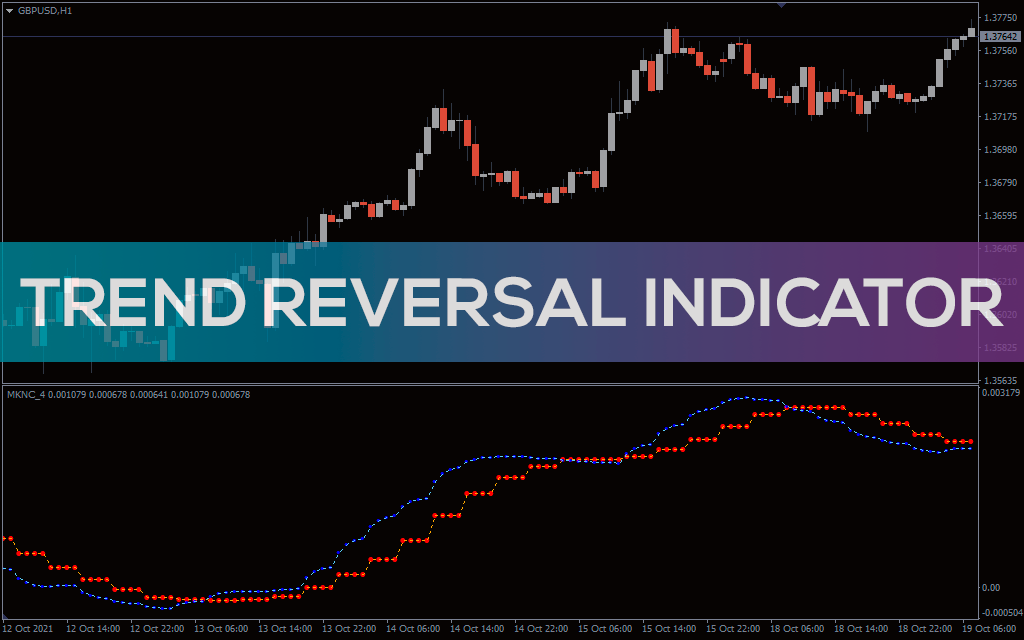Trend reversal, or change of direction, is a term used in the Forex market and other financial markets to describe a change in the price movement of an asset. This change in direction can shift from bullish to bearish or from bearish to bullish.
In simpler terms, when an upward or downward trend in the Forex market comes to an end and the price starts moving in the opposite direction, it is said that a trend reversal has occurred. Accurately identifying the timing of a trend reversal is one of the main challenges for Forex traders, as it can provide profitable opportunities but, if misjudged, can lead to significant losses.
To better understand trend reversal, it’s essential to be familiar with the concepts of upward and downward trends. In an upward trend, the price of an asset is continuously increasing, with each new high above the previous high and each new low above the previous low. Conversely, in a downward trend, the price of an asset is consistently decreasing, with each new high below the previous high and each new low below the previous low.
When market conditions change and economic, political, or psychological factors impact the current trend, the likelihood of a trend reversal increases. In these situations, traders must carefully pay attention to market signals and utilize technical and fundamental analysis tools to identify potential reversal points.
It is important to note that trend reversals are not always certain, and after a short-term movement in the opposite direction, the main trend may resume. For this reason, risk management and the use of appropriate strategies to control losses when trading trend reversals are crucial.
Ultimately, trend reversal is a natural phenomenon in the Forex market, and understanding it is essential for every trader. By thoroughly analyzing the market and employing suitable analytical tools, the chances of success in trend reversal trades can be improved.
Important Note: This text serves as a general introduction to the concept of trend reversal in Forex. For investment decisions, it is always advisable to seek guidance from financial experts.
Identifying Trend Reversal Without Indicators
In financial markets, accurately detecting trend reversal points is of great importance. Professional traders understand that correctly identifying these points can lead to significant profitability. One of the main challenges in this regard is the over-reliance on indicators. While these tools can provide useful information, they alone cannot precisely predict trend reversals. In this article, we will explore methods for identifying trend reversals without using indicators.
Understanding price behavior is the first fundamental step in this process. Price-based technical analysis helps traders identify price patterns and use them to forecast future trends. Classic patterns such as head and shoulders, double tops, and double bottoms are among the powerful tools in this area. These patterns provide important signals about the likelihood of a trend change by forming distinct price structures.
In addition to price patterns, support and resistance levels play a crucial role in identifying trend reversals. These levels are areas where the price has historically tended to reverse. Accurately identifying these levels and observing the price’s reaction to them can provide valuable insights into the potential for a trend change.
Another important factor in detecting trend reversals is trading volume. Unusual increases or decreases in trading volume can signal a shift in the balance of supply and demand. These changes in volume may serve as supplementary signals to confirm price patterns and support and resistance levels.
Ultimately, market psychology analysis can also be effective in identifying trend reversals. Understanding the collective behavior of traders and identifying overbought and oversold conditions can assist in pinpointing reversal points.
Of course, identifying trend reversals without indicators requires experience, practice, and careful analysis. There is no infallible method for accurately predicting the market, and trading comes with risks. However, by mastering price-based technical analysis techniques and other influencing factors, one can increase the likelihood of successfully identifying trend reversals.
Remember that no system is flawless, and combining different analytical methods can enhance predictive accuracy. Additionally, risk management and emotional control are key factors for success in trading.
Example of Identifying Trend Reversal Without Indicators
To illustrate how to identify trend reversals without indicators, we will use the example of the euro against the US dollar (EUR/USD), which has formed a head and shoulders pattern after an upward trend on the daily timeframe. According to the rules of this pattern, fully explained in the article “Understanding the Head and Shoulders Pattern in Technical Analysis,” a short position can be initiated after a break of the area known as the “neckline.”
In this pattern, the breaking of the neckline confirms the trend reversal, allowing traders to confidently enter a short trade to profit from the market decline.

As shown in the image, the corrective price movement after the formation of the pattern lacks sufficient strength to return to previous price levels. After breaking the neckline and the main trend line, the downward trend is fully established.
A noteworthy aspect of this analysis is the presence of specific candlestick patterns at various points of the head and shoulders pattern. Patterns such as bearish engulfing, harami, and doji at different locations within the pattern enhance the validity of the trend change signal. For example, the bearish engulfing pattern at the left shoulder and head of the pattern indicates the strength of sellers and the likelihood of a trend change. Additionally, the doji pattern at the right shoulder reinforces market uncertainty and the potential for the downward trend to continue.
Identifying Trend Reversal with Technical Analysis Indicators
In financial markets, accurately determining the timing of trend reversals is one of the main challenges for traders. Technical analysis indicators are powerful tools that can significantly assist in this regard. These tools analyze historical data on price, volume, and other market factors to provide signals that can help predict trend changes.
One of the most important indicators for identifying trend reversals is the Moving Average (MA). A moving average is a line that averages the price over a specified time period. There are two main types of moving averages: Simple Moving Average (SMA) and Exponential Moving Average (EMA). The crossover of these two averages is often considered a signal for a trend change. For example, when a short-term moving average crosses above a long-term moving average, it may indicate the beginning of an upward trend.
Another indicator that is useful in identifying trend reversals is the RSI (Relative Strength Index). The RSI is an oscillator that fluctuates between 0 and 100. This indicator measures the strength of a trend. When the RSI reaches the overbought zone (usually above 70), it indicates a potential for a downward trend reversal. Conversely, when the RSI falls into the oversold zone (typically below 30), it may signal a potential upward trend reversal.
The MACD (Moving Average Convergence Divergence) is also a popular oscillator for detecting trends and their reversals. The MACD is calculated from the difference between two moving averages, with a signal line added. The crossover of the MACD line with the signal line can serve as a signal for a trend change. Additionally, divergence between the price and the MACD can indicate weakness in the trend and the potential for a reversal.
Bollinger Bands are also an effective tool for identifying trend reversals. This indicator draws two standard deviation lines around a moving average. When the price approaches the upper Bollinger Band, it may indicate overbought conditions and the possibility of a trend reversal. Conversely, when the price nears the lower Bollinger Band, it may signal oversold conditions and the potential for an upward trend reversal.
It’s important to note that using indicators alone is not sufficient; they should be combined with an analysis of other market factors such as trading volume, price patterns, and economic news. Additionally, each indicator has its strengths and weaknesses and may perform differently under varying market conditions. Therefore, traders should use these tools carefully and leverage them alongside other analytical methods.
Ultimately, the most crucial aspect of trading is risk management. No system can predict market movements with 100% accuracy, so using stop-loss orders and taking profits is essential.
In technical analysis, accurately identifying trend reversal points is one of the most important skills for traders. Indicators, as auxiliary tools, play a significant role in this process. In this article, we will examine two widely used indicators: trend lines and moving averages, for detecting trend changes. Additionally, we will mention other technical analysis indicators that can be helpful in this regard.

Trend Line: A Simple Yet Powerful Tool
The trend line is one of the simplest yet most effective tools in technical analysis. This line indicates the overall direction of price movement and is drawn by connecting at least two consecutive peaks or troughs. A breakout of the trend line is considered a strong signal for a trend change.
- Uptrend Line: Drawn by connecting consecutive troughs, indicating an upward trend.
- Downtrend Line: Drawn by connecting consecutive peaks, indicating a downward trend.
Moving Average: Trend Following and Change Detection
The moving average is the average price of an asset over a specified period. This indicator smooths out short-term price fluctuations and provides a clearer view of the overall market trend. There are various types of moving averages, each with its specific applications.
- Simple Moving Average (SMA): The simple average of closing prices over a specified period.
- Exponential Moving Average (EMA): Gives more weight to recent prices and is more sensitive to price changes.
Using Moving Averages to Identify Trend Changes:
- Moving Average Crossovers: When a short-term moving average crosses above a long-term moving average, it can signal a trend change.
- Break of Moving Average Line: When the price crosses above or below a significant moving average, it can indicate a trend change.

Conclusion
- Accurately identifying trend reversal points is one of the main challenges in trading. Indicators, as auxiliary tools, can assist you in this process. However, no indicator can guarantee that you will always make correct trading decisions. A combined use of multiple indicators, along with fundamental analysis, can provide you with a better perspective on the market.

